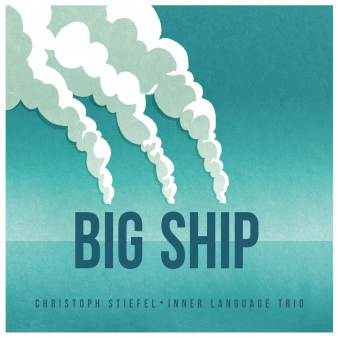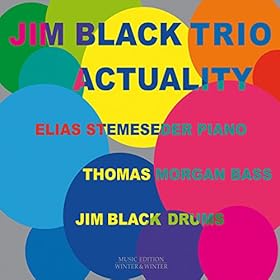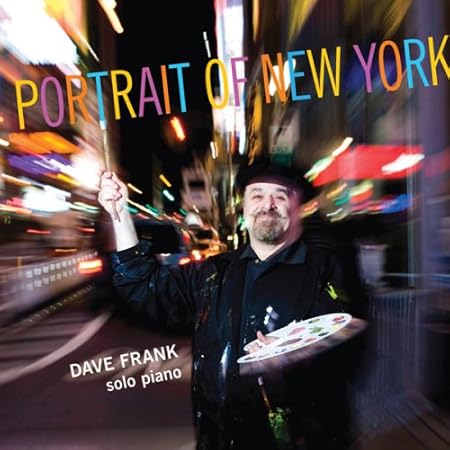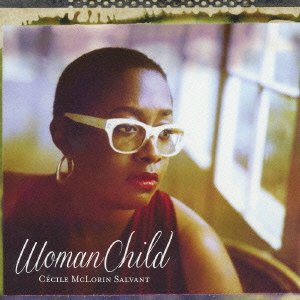Gary Peacock & Marilyn Crispell
Azure By Thom Jurek
By Thom Jurek The release of Azure, a duo recording by bassist Gary Peacock and pianist Marilyn Crispell, may have been inevitable, but it sure was a long time coming. Peacock and Crispell have played together on tour for years, but this is their first opportunity to record as a pair. Under Crispell's leadership, they teamed with the late Paul Motian on two of the finest piano trio offerings of the last two decades: Nothing Ever Was, Anyway and Amaryllis. There are three tunes composed by each artist, three duo improvisations, and each has a solo track. Crispell's "Patterns" opens the proceeding on a lively note. A complex, knotty, muscle-flexing duet that is full of quick call-and-response motivic thought and counterpoint, it reveals the duo's considerable dialogic power. On the other end of the spectrum is Peacock's lovely, melodic "The Lea," which extends naturally from both the folk and blues traditions. He opens with his solo; it states its loose theme followed by his improvisation upon it for half the tune's length. When Crispell enters, she underscores the song-like nature of the piece, painting its frame with melancholy, minor-key chord voicings, and brief, luxuriant fills. The set's longest cut, "Waltz After David M," by Crispell, is elliptical and graceful with a gorgeous melody. Peacock's support offers avenues for more expansive -- yet subtle -- thought in the middle's long improvisational section. Though these pieces are quite satisfying, the duo's real poetic is displayed in their improvisations, especially the hypnotic "Blue," with Crispell's Monk-tinged chords and tight, angular lines. Peacock's playing reveals so much wood in his tone that it feels percussive -- despite his continual bluesy, swinging riffs and vamps. The title cut that closes the proceeding is crystalline, full of space, elegance, and grace. It sounds like the seamless interplay between the two is not improvised but composed and arranged. On Azure, the effortless communication between these players is like a conversation that is so intimate it can, at times, feel as if the listener is eavesdropping. Hopefully these two will be motivated to do this again.
Misha Tsiganov
The Artistry Of The Standard By Edward Blanco
By Edward BlancoVeteran Russian pianist Misha Tsiganov has an extensive discography featuring original compositions and, like most musicians, blending a few standards for familiarity along the way. With The Artistry Of The Standard, the pianist presents an entire album of standards reprising the music of jazz greats Wayne Shorter, Charlie Parker, Wes Montgomery and John Coltrane among others. Jazz standards however, is not the only genre represented on the nine-piece repertoire as Tsiganov also includes music from the Great American Songbook drawing songs from Cole Porter, Richard Rodgers and Jerome Kern as well as an uncommon pop tune from Stevie Wonder ("Make Sure You're Sure").
Two elements that make this an exceptional outing are, Tsiganov's superb arrangements making much of the tunes sound like new instead of warn out renditions. The other obvious key to the success of this effort, is the collection of A-list players helping him interpret the standards. Performing with a quintet that features a horn section of saxophonist Seamus Blake and trumpeter Alex Sipiagin—both blowing the house down on the nine-minute version of "Get Out Of Town," is just one indication of how good this album is. The horns are silent on the Kern standard "The Song Is You" as Tsiganov takes charge with bassist Boris Kozlov and drummer Donald Edwards providing all the background support the pianist needs as he delivers one masterful performance providing one excellent treatment of a beautiful time-honored standard.
The pianist's affinity for the music of saxophonist Wayne Shorter is evident as he opens the music with a blistering read of the icon's "Fall" and continues with another lively read of the familiar "This Is All For Albert" showcasing another gorgeous piano solo, a Sipiagin push and more from tenorist Blake. With the pianist leading the way, the oft-recorded "Falling In Love With Love" is almost unrecognizable with terrific improvisational twists and changes disguising the melody and making this version quite unique. Tsiganov's talents as a bebop and post-bop player and interpreter are on display on the very boppish Coltrane tune "Mr. Day" as are the appreciable chops of saxophonist Blake with some steamy solos.
Jazz pianist Misha Tsiganov long ago cemented his place in the jazz world and certainly deserves recognition as one of the most celebrated jazz pianist of our time as the music of The Artistry Of The Standard truly attests. Leading an outstanding cadre of jazz musicians—all major players in their own right—this quintet is one formidable ensemble that plays tight and delivers the music with gusto. The standards have never sounded as robust and challenging as the way Tsiganov arranges and presents here, exemplary on all fronts.
Track Listing:
Fall; Get Out Of Town; The Song Is You; Ah-LeuCha; This Is For Albert; Four On Six; Falling In Love; Mr. Day; Make Sure You're Sure.
Personnel:
Misha Tsiganov: piano; Alex Sipiagin: trumpet, flugelhorn; Seamus Blake: tenor saxophone; Boris Kozlov: bass; Donald Edwards: drums.
Stan Getz & Kenny Barron
People Time - The Complete Recordings ( 7 CD's ) By Geoffrey Himes at JazzTimes
By Geoffrey Himes at JazzTimes When a jazz musician crosses the boundary of 60, he or she must decide what to do with phrases already played thousands of times. Do you just keep playing them with less and less emotional force? Do you replace them with a whole new bag of tricks? Or do distill your playing like whiskey, getting rid of the superfluous notes so only the highest-proof music remains?
The last four years of Stan Getz’s life were devoted to such a distillation. Five months after he turned 60, the tenor saxophonist brought his quartet to Copenhagen’s Café Montmartre on July 6, 1987. No longer did Getz seem to be exploring for the right notes by sending out search parties in all directions; now he went directly to the right phrase at the right time. The sharp focus was reinforced by the forward push from drummer Victor Lewis, a master of the cymbals; bassist Rufus Reid, a master of melody; and pianist Kenny Barron, a master of turning single-note lines into harmony.
The radio broadcast from that evening was so fruitful that it yielded not just one of the Getz’s best albums but two: Anniversary, released in 1989, and Serenity, in 1991. The saxophonist began to think of the Danish nightclub as a good luck charm and returned there in March 1991, for four nights of duo performances with Barron, released a year later as People Time. Except for one night in Paris, these would be Getz’s last public performances, for he would die of liver cancer on June 6.
It’s unclear whether or not he knew he was dying. Barron says he talked to Getz in May about a summer tour that was to begin in July. It’s clear, however, that the saxophonist was very sick; he often had to pause to catch his breath and conquer his pain between tunes, and he cancelled the eighth show of the four-day run for health reasons. It’s also clear that the process of distillation had proceeded even further since the 1987 dates. Getz’s lines had grown even cleaner and leaner, sculpted by pauses into thin phrases of pure lyricism.
The original two-CD set, People Time, offered 14 of the week’s 48 performances. Now all 48 numbers (covering 24 different tunes) have been released as a seven-CD box set, People Time: The Complete Recordings, one disc for each of the seven sets. Also in the box is a long essay by Gary Giddins, making the argument that all 48 numbers deserve to see the light of day. It’s not, he concedes, that Getz and producer Jean-Philippe Allard made the wrong decisions in picking the 14 best tracks for the original release. Rather, Giddins argues, this is one of the unacknowledged high points of jazz history, and hearing it unfold over seven sets and four days is an unparalleled pleasure.
Perhaps it’s a matter of personal taste. The box set provides a superb listening experience, but neither it nor the original two-CD set would be a desert-island disc for me; in fact, I prefer the muscularity of the 1987 quartet sessions to the intimacy of the 1991 duo dialogues. One can’t deny Giddins’ argument, however, that the seven discs unfold like a story of two men growing closer and closer together until they reach a rare telepathic rapport on the final three sets.
On the first set of the third night, an ailing, dissatisfied Getz replaced the reed on his horn. He tested out the new reed on “You Stepped Out of a Dream,” and then threw off all concerns about health and equipment for a sublime reading of Benny Golson’s elegy for Clifford Brown, “I Remember Clifford.” Perhaps the autumnal twilight of this ballad fit Getz’s frame of mind, because his famously tender tone had seldom worn the bruise of loss so revealingly. And Barron was right there with him; his chording never fell into a repeating pattern but moved with the sax as if offering consolation to every painful phrase. The set ended with a spirited version of “The Surrey With the Fringe on Top”; Getz ratcheted up the tension by chopping out pieces of the familiar melody while Barron pursued a duet between his funky left hand and lyrical right.
Giddins calls the second set of that evening “one of the great Stan Getz sets, one of the great Kenny Barron sets, and arguably the best of the Getz-Barron sets.” Four of the six numbers wound up on the original album, and the other two are nearly as good. Getz’s distillation of his sound didn’t reduce the forcefulness or exuberance of his playing, but merely gave it better framing by clearing away the clutter, as he proved on “East of the Sun (and West of the Moon)” and “Night and Day.” But the highlight of the set, of the entire week, and perhaps of Getz’s career is the version of Charlie Haden’s “First Song.” Introduced by Barron’s spare, mood-setting piano, this ballad tribute to Haden’s wife, Ruth Cameron, became, in Getz’s emotionally naked, pause-punctuated solo, an admission of every regret and gratitude he has accumulated during his long life.
It’s worth noting that most of the highlights of this box set are neither show tunes nor Getz originals but rather compositions by distinguished jazz musicians: Haden, Dizzy Gillespie, Thad Jones, Eddie Del Barrio, Mal Waldron, Benny Carter (who wrote the title tune) and Golson, who contributed three different titles. Golson is a lovely saxophonist but he could never play like Getz, while Getz could never write like Golson. They needed each other, and jazz needs more such symbiotic relationships between writers and players.
Paul Bley
Play Blue - Oslo Concert By Mike Shanley at JazzTimes
By Mike Shanley at JazzTimesPaul Bley’s 1973 album, Open, to Love, set a precedent as both a document of the pianist’s skill in the solo setting and for the rich production that has become an expectation with ECM Records. Despite that artistic success, Bley wouldn’t release another solo album for ECM until 2007, when he returned with Solo in Mondsee. Thankfully, it wasn’t as long of a wait for this third solo piano recital, taken from a performance at 2008’s Oslo Jazz Festival.
Hearing Bley in action, applying his own sense of order to various approaches, still feels electrifying. In Way Down South Suite the blues shows up twice, just long enough for him to twist it around. In the early minutes, he plays a melody in the upper register, giving it a feeling of innocence. Later in the 15-minute piece, he interrupts a different blue line with a dissonant turn, as if to talk himself out of it.
In between, he creates drama with a pregnant pause and muffles piano strings with one hand while striking the keys with the other. The equally lengthy “Far North” springs from a simple chordal riff, where his hands chase one another and briefly lapse into an off-kilter stride; the energy is high even when Bley just lets chords resonate gently. Following a 90-second ovation, the set closes with a rapid upper-register version of Sonny Rollins’ “Pent-Up House,” to which Bley adds some avant-garde thunder for punctuation.
Larry Goldings, Peter Bernstein, Bill Stewart
Ramshackle Serenade By Chris M. Slawecki
By Chris M. SlaweckiLike just about every historically great organ trio, these three expert musicians are strongly rooted in funk and jazz: Organ player Larry Goldings and drummer Bill Stewart both spent time smoking riffs for saxophonist Maceo Parker (not at the same time), while no less an authority than Jim Hall
once called Peter Bernstein the most impressive jazz guitarist he'd ever heard. These shared roots especially grow through this set's "Mr. Meagles," through which Goldings and Bernstein respectively move and groove like Jimmy Smith and Grant Green.
"Sweet and Lovely" is more than a standard lovingly rendered by these six capable hands—it's an accurate summation of this entire set. "We have developed a group sound in a completely natural way instead of having a sound that is dominated by the organ," Goldings suggests. "Maybe it's because of the respect we have for one another as musicians with strong personalities."
They respectfully open their Serenade with Goldings' tribute to drummer Max Roach. Organ and guitar riffs stroll into and then jump out of this leisurely glide, move to swap brassy chords (which sound like they'd be the horn chart in a larger ensemble) and then open up for increasingly long and complex drum rolls and cymbal splashes that honor this tune's namesake. In another namesake tribute, Goldings' chords wrap up and nestle Bernstein's opening guitar like luxurious bedclothes as it dances through all the beauty and romance of Antonio Carlos Jobim's ballad for his youngest child, daughter "Luiza." These three voices sing the title track "Ramshackle Serenade" in a truly singular voice that radiates the warmth of jazz from the American heartland nurtured by Pat Metheny, Bruce Hornsby and similar mainstream artists. "We all wanted it as the album's title," Goldings explains. "I think that sometimes we as a band let feelings of dissolution and chaos meet up with strength and beauty. It's fun to take something beautiful and harmonically and rhythmically turn it around so that certain darker shadows mix in. Tension is crucial when you want to make good music."
Stewart builds up "Blue Sway" upon guitar and organ chords that rock it back and forth, its melody and rhythm as perfectly titled as "Sweet and Lovely" and as the serene and floating rendition of Horace Silver's "Peace" which closes this set.
Track Listing:
Roach; Luiza; Simple as That; Ramshackle Serenade; Mr. Meagles; Sweet and Lovely; Blue Sway; Useless Metaphor; Peace.
Personnel:
Larry Goldings: Hammond organ; Peter Bernstein: guitar; Bill Stewart: drums
The Stanley Clarke Band By Thom Jurek
By Thom Jurek The 2010 self-titled release by the Stanley Clarke Band is aptly titled; it actually feels more like a band record than anything he's done in decades. This isn't saying that Clarke's solo work is somehow less than, but when he surrounds himself with musicians that are all prodigies in their own right, the end results tend to be more satisfying. Produced by Clarke and Lenny White, his band is made up Compton double-kick drum maestro Ronald Bruner, Jr., Israeli pianist/keyboardist Ruslan Sirota, and pianist Hiromi Uehara (aka Hiromi) who plays selectively but is considered a member. There are guests, too, including a horn section, a couple of guitarists in Rob Bacon and Charles Altura, and saxophonist Bob Sheppard. Clarke plays his usual arsenal of basses. Sirota and Hiromi also contribute compositions to the album. They include the former's set opener "Soldier." While its intro is quiet and melodic enough, it evolves, first into a modal study with Clarke playing the melody before it kicks into jazz-rock overdrive with Altura playing a distorted rhythm guitar to Clarke's Alembic tenor bass. Dynamics shift and turn; they make the track a multi-faceted investigation with Sirota's piano solo sourcing both McCoy Tyner and Herbie Hancock. Hiromi's "Labyrinth" melds elements of "My Favorite Things" to modern post-bop and classical architectures; the breakbeats by Bruner add a funky touch, and Clarke's layered basses become a focal foil for the piano. There is also an updated reading of Chick Corea's "No Mystery," from Clarke's days with Return to Forever, that captures the tune's near transcendent curiosity without trying to re-create it. The drama brought by Clarke's bass is tense and declamatory. "Sonny Rollins" contains the theme from "Don't Stop the Carnival" and is Caribbean-flavored, but pays tribute to the saxophonist's entire career. Written by Clarke, it contains wonderfully knotty passages on acoustic as well as electric basses; Sheppard's fine soloing and fills make it a jumper. "I Wanna Play for You Too" is funkily self-explanatory for Clarke fans, while "Bass Folk Song #10" is a gorgeous solo piece. "Fulani" is an excellent piece of contemporary fusion, where "Larry Has Traveled 11 Miles and Waited a Lifetime for the Return of Vishnu's Report," dedicated to Joe Zawinul, is a clumsy, failed attempt at summing up the music's history to date. The ballads, including "Bass Folk Song No. 6," which closes the set, work less well, but these are minor complaints on an otherwise fine recording.




























